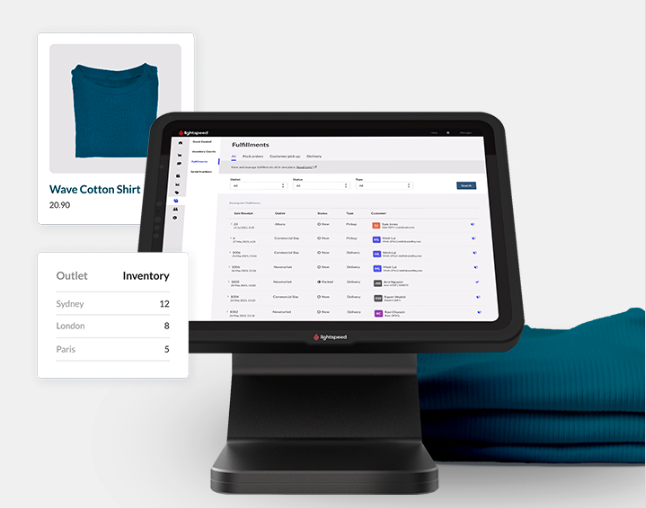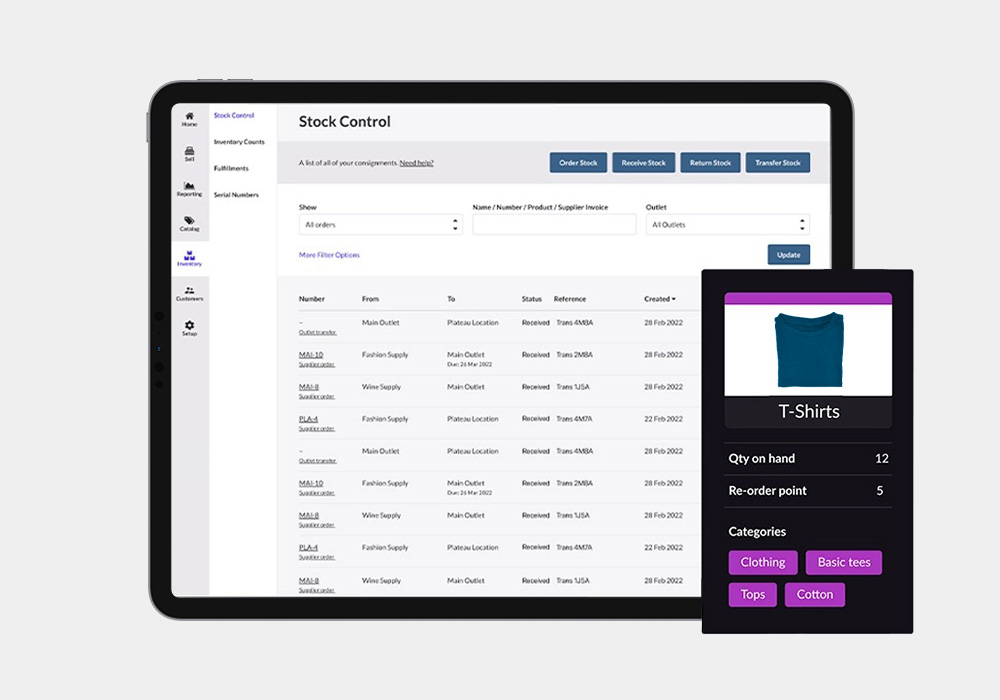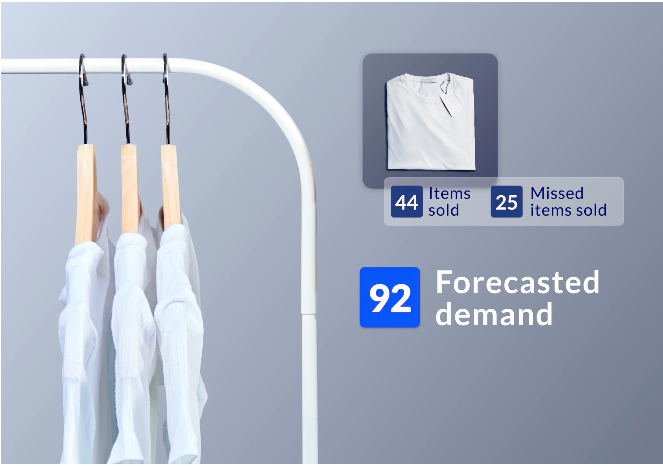
As retailers across North America plan for an influx of sales during the holiday season, inventory is top of mind. Often, retailers aren’t as prepared as they would like to be: stockouts, overstocking, manual processes and more inventory management challenges can get in the way of smooth business operations.
However, using the right technology can take retailers a long way. Lightspeed equips retailers with the ability to overcome these challenges and thrive. Lightspeed’s industry-leading inventory management and analytics solutions help retailers tap into success faster.
In this article, we’ll cover all the ways that Lightspeed empowers businesses with solutions to challenges in retail inventory management.
We’ll discuss:
- Common inventory management challenges in retail
- How Lightspeed addresses inventory management challenges
- Why retailers choose Lightspeed for inventory management
- A case study in how the right software can drive retail growth
A guide to multistore inventory management
Check out our guide to the stock management practices every multi-outlet retailer should know.
Common retail inventory management challenges
There are many factors that can make it more difficult to manage inventory, leading to profit losses and operational inefficiencies.
Inaccurate and manual inventory tracking
Physically counting inventory to see what’s in stock and what needs to be reordered can lead to stock discrepancies. Specifically, these occur as a result natural human error. Manual inventory tracking is not only time consuming–it can actually impact your bottom line. Basically, in today’s omnichannel world, this just isn’t a realistic or productive way for retailers to count inventory.
Overstocking and stockouts
Overstocking has plenty of consequences, including obstructed cash flow. Excess inventory ties up capital that could be used for other business needs. Plus, carrying costs may increase: you may need to pay for additional storage facilities and associated fees to account for surplus inventory. There’s also a risk of obsoletion, resulting in having to completely write off or dispose of products. And if you decide to discount products, you’ll face a significant drop in profit margins.
Stockouts are similarly devastating to a retailer’s bottom line. Customers have plenty of options these days. If your store doesn’t have the item they want in stock, they will go elsewhere to find it, ultimately leading to lost sales. If a bestselling product is out of stock, especially during peak sales periods, your profits will be at risk.
Ultimately, these two challenges highlight the balancing act of maintaining optimal stock levels.
Lack of real-time data
Without real-time visibility into inventory, information quickly becomes outdated and delayed. This leads to missed opportunities. For instance, not being aware if a popular product is low in stock can cause stockouts and lost sales.
You may also not be able to meet customer demand effectively due to inaccurate data and an inability to predict future demand. This can cause under- or over-ordering. Further, without up-to-date data, retailers may overestimate the need for some items, leading to overstocking.
Inaccurate demand forecasting
Accurately predicting customer demand is crucial, but also challenging. Gaps in forecasting can lead to either overstocking or stockouts, both of which are costly. And depending on the nature of your retail business, it’s essential to predict demand during peak seasons. A lack of forecasting can negatively impact the execution of other aspects of the business–from pricing strategies to marketing campaigns.
Inadequate warehouse layout
An inefficiently designed warehouse can lead to wasted time and money. Workers may take longer to locate, pick and pack items. Essentially, this leads to delayed shipments, slow order fulfillment and increased labor costs. These tasks should be as easy as possible to carry out to reduce operational inefficiencies. An inadequate warehouse system can also result in misplaced stock, higher risk of safety hazards and reduced inventory accuracy.
Increasing competition
Adapting your inventory processes in a highly competitive market in which consumers have (literally) millions of options is a good idea if you want to stay afloat in your industry. You need to maintain optimal stock levels, eradicate stockouts and overstocking, and ensure operational efficiency on every front.
Customers demand speed and accuracy during their buying process. Do some research: if your competitors are more reliable when it comes to order delivery and stock availability, consider streamlining your inventory management process. Plus, controlling inventory-related costs by minimizing loss of sales through stockouts and tied-up funds due to overstocking, will put your business in a more competitive position.
Inventory loss
Shrinkage is a reality that all retailers must face. Inventory loss through theft, damage, fraud or data-entry errors leads to significant financial impacts. When shrinkage occurs, retailers still have to eat the cost of the items purchased to begin with while missing out on the opportunity to sell.
Security measures, controlling access to inventory, regular audits and employee training are among the strategies for preventing inventory loss.
Poor production planning
Production planning involves producing, manufacturing and sourcing goods to align with customer demand, expected sales, existing inventory levels and other considerations. Without a streamlined system for managing inventory, production planning is thrown off, leading to wasted resources, financial difficulties and ineffective solutions.
Complex multilocation management
Now imagine all the problems we’ve discussed, applied to multiple retail locations. It’s just not feasible for larger retailers to have poor processes and operational inefficiencies at any level–but especially for something as important as inventory management.
When it comes to managing inventory across multiple locations and channels, retailers need complete oversight. Tracking and transferring stock, viewing real-time availability, connecting with suppliers, managing purchasing: it all becomes more complex when applied to more than one store or channel. That’s why it’s essential to have an inventory management solution that supports multistore retailers.

How Lightspeed addresses inventory management challenges
The many retail inventory management challenges we’ve discussed may be daunting, but it doesn’t have to be that way. With Lightspeed, retailers can find peace of mind with advanced inventory management and insights.
Real-time inventory management and tracking
Lightspeed addresses overstocking, understocking and complex multi location management in one solution.
Real-time tracking: Lightspeed updates in real time to ensure that stock levels and sales are synchronized. This is because sales and inventory data are integrated, enabling automatic, real-time inventory updates as sales are processed. You can operate with confidence, knowing that all pertinent data is recorded and up-to-date. This completely eliminates the need for any manual inventory tracking and data entry–meaning you and your staff have time to focus on other areas of the business.
Automated reordering: Lightspeed prevents stockouts and saves time-consuming processes with automated reorder points. Low stock alerts make it simple to keep up with inventory demands. You can also automate supplier and product information in a single click through Lightspeed NuORDER, which offers retailers access to millions of products and thousands of brands. Built-in purchase orders let you make orders directly in Lightspeed Retail. Plus, easy-to-use inventory counting tools allow you to keep on top of inventory counts.
Multilocation and multichannel management: Lightspeed provides complete inventory visibility across all retail stores and channels. You can track inventory levels and SKUs from anywhere, create product variants and identify stock across locations using unique serial numbers. You can easily manage inventory across stores, your ecommerce site, various marketplaces and social media platforms.

Advanced insights for fast-tracked growth
Lightspeed Insights empowers retailers with precise, in-depth analytics so they can make decisions that drive growth. These insights are crucial when it comes to effective inventory management and boosting profit.
Custom reports: These detailed reports contain key sales and inventory data that can be scheduled for any time, allowing you to make real-time strategic decisions. This way, you can analyze trends to make better buying decisions, understand what’s working and what isn’t from across your product line, and see what’s selling best.
Optimize inventory: Retailers can capture every sale with the ability to identify popular products and avoid stockouts. Sell-through data filtered by a range of variables can help retailers determine exactly what to order and how often, as well as prioritize reorders effectively.
Forecast mode: Using historical data and inventory trends, retailers can forecast for non-seasonal replenishment and beyond. Suggested order quantities allow retailers to avoid over and understocking product to reach optimal stock levels. Not only that, this feature lays out future sales predictions and inventory needs, letting you plan ahead to ensure optimal sales.

Why choose Lightspeed for inventory management?
Our solutions go beyond just inventory. Lightspeed is a comprehensive POS and payments platform that retailers can use as a foundation to grow on, with world-class support along the way.
Scalability for growing businesses
Lightspeed is a solution that scales with businesses to support growth and increasing inventory complexity. Lightspeed’s inventory management software captures all inventory data in real time to paint a full picture of stock levels, future demand, availability and more.
Instead of adding more work for retailers, Lightspeed streamlines information with advanced inventory tools and insights so you can make the right decisions for your business. If your sales grow and your business scales, Lightspeed not only meets you where you are, but accelerates that growth by consolidating all the data and features you need in one place.
User-friendly interface and support
Lightspeed’s highly configurable and simple interface makes it easy for retailers and their employees to assess and manage inventory. An ultrafast, stable and reliable platform ensures that no data is ever lost.
Support is also key to a business’ growth. That’s why Lightspeed offers 24/7 support and personalized guidance from industry experts. As you grow, this dedicated support is a valuable resource that will guide you through platform configurations, new workflows and any questions you may have.
Comparing inventory valuation methods: a case study
The inventory valuation method you choose can shape the way you make key business decisions.
First in, first out (FIFO): an inventory management method that assumes the oldest inventory is sold or used first. The oldest stock–the products that were added first–are the first to be sold. This helps manage costs and reduce the risk of obsolescence, which for retailers often means seasonal or micro-trendy items being sold before they become outdated. In times of rising prices, this method may lead to more accurate costing because older inventory is used first, indicating lower cost of goods sold (COGs).
Last in, first out (LIFO): an inventory management method in which items that were most recently acquired are sold or used first. This method is often used for products that aren’t perishable, and the COGs can vary over time. Businesses facing increasing inventory costs may use this method. And since older stock remains in inventory, the value of the ending inventory may be lower under LIFO than FIFO.
To get a more detailed understanding of these methods and how they impact inventory valuation, read our complete guide.
Case study: a retailer’s success with Lightspeed
Let’s dive into a real-life instance of a retailer successfully overcoming inventory challenges with Lightspeed.
The need for modern technology
Apparel retailer DenimBar has been in business for 54 years, and strikes a balance between adapting to changing fashion trends, while maintaining its local charm. But when it came to technology, they were a little behind.
Before switching to Lightspeed, they used a traditional cash register. With over 10,000 SKUs, they had to manually track sales and inventory, a time-consuming and error-prone task. Additionally, they lacked visibility into inventory performance, suppliers and customers.
To address these issues and modernize its operations, DenimBar turned to Lightspeed.
“We have a lot of inventory, but the process was very easy. It has been straightforward and easy to figure out. Even my mom, who’s 75 years old, started using it right away.”
Streamlining with NuORDER
Now, product orders are simple for the team with NuORDER by Lightspeed. They already used NuORDER, but Jennifer says having the two systems integrated has helped them streamline.
What does that look like? For example, before it took the team around 20 minutes to upload 50 items to their system. However, with NuORDER by Lightspeed, they can now do it in just a minute—amounting to 95% time savings.
Better inventory and business insights
The team has more data visibility than ever and can make smarter business decisions as a result. Jennifer now has access to in-depth inventory reports, which she uses to analyze trends and identify top-performing products.
“I can look through and see performance per brand. From there, I send a note to the people in charge of buying. That’s really helpful because while we know what sells on a daily basis, the year-end reporting makes it very clear where we need to make adjustments. It was just easy to see, ‘Okay, we need to make a cut there. We need to buy more of this one,’ and that type of thing.”
With Lightspeed’s intuitive platform, advanced inventory software, and seamless multichannel capabilities, the DenimBar team can focus on running and growing the business.
Grow faster with Lightspeed POS for inventory management
Experiencing inventory management problems shouldn’t be the norm for retailers. Lightspeed arms you with sophisticated inventory software and insights to eliminate stockouts, overstocking, manual tracking and visibility issues.
Lightspeed helps retailers:
- Use data to make decisions that improve profit margins.
- Automate inventory workflows to promote efficiency.
- Connect with suppliers in a click with built-in catalogs.
- Track inventory across all locations and channels.
And so much more. If you’re a retailer who wants a streamlined inventory management process, watch a Lightspeed Retail demo today.
FAQ
How does Lightspeed help prevent stockouts?
Lightspeed prevents stockouts through real-time tracking capabilities, sales and inventory reports, inventory counting tools and reorder points with low-stock alerts.
What kind of reports can I generate with Lightspeed POS?
Retailers can generate comprehensive, customized reports including sales, inventory and tax and payments data. Retailers can use these data points to analyze trends, view top-performing products, and identify areas of improvement and opportunity.
Is Lightspeed suitable for small businesses?
Lightspeed is a POS and payments platform suitable for both complex, multilocation businesses as well as small businesses. The platform offers inventory management software, Advanced Insights and top integrations for growing businesses.
How does Lightspeed POS automate inventory processes?
Retailers can automate crucial aspects of inventory management with Lightspeed, which include purchase orders, inventory counting, reorder points, reports, price changes and much more.

News you care about. Tips you can use.
Everything your business needs to grow, delivered straight to your inbox.


